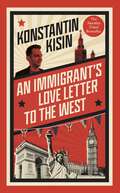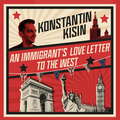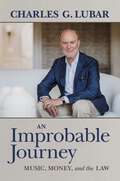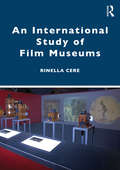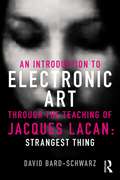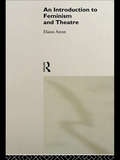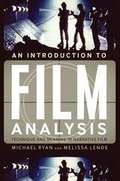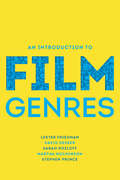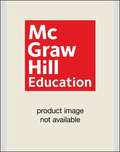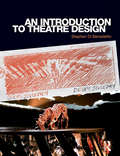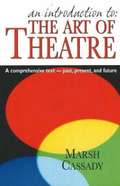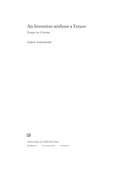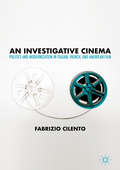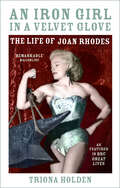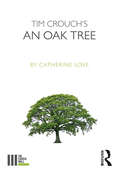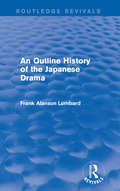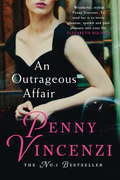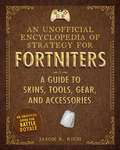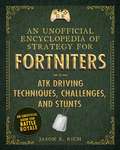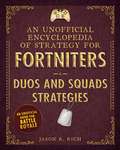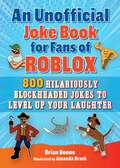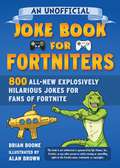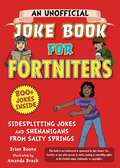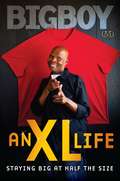- Table View
- List View
An Immigrant's Love Letter to the West
by Konstantin KisinFor all of the West's failings - terrible food, cold weather, and questionable politicians with funny hair to name a few - it has its upsides. Konstantin would know. Growing up in the Soviet Union, he experienced first-hand the horrors of a socialist paradise gone wrong, having lived in extreme poverty with little access to even the most basic of necessities. It wasn't until he moved to the UK that Kisin found himself thriving in an open and tolerant society, receiving countless opportunities he would never have had otherwise.Funny, provocative and unswervingly perceptive, An Immigrant's Love letter to the West interrogates the developing sense of self-loathing the Western sphere has adopted and offers an alternative perspective. Exploring race politics, free speech, immigration and more, Kisin argues that wrongdoing and guilt need not pervade how we feel about the West - and Britain - today, and that despite all its ups and downs, it remains one of the best places to live in the world.After all, if an immigrant can't publicly profess their appreciation for this country, who can?
An Immigrant's Love Letter to the West (Karen Pirie #4)
by Konstantin KisinTHE SUNDAY TIMES BESTSELLER'A lively and spirited book' DOUGLAS MURRAY'A paean to the freedom and dignity that many in the West take for granted' PETER BOGHOSSIAN'A cool, steady but urgent message that we should value and protect what we have' SPIKED'Kisin's book [has] a powerful moral quality that makes it worth reading' SUNDAY TIMESFor all of the West's failings - terrible food, cold weather, and questionable politicians with funny hair to name a few - it has its upsides. Konstantin would know. Growing up in the Soviet Union, he experienced first-hand the horrors of a socialist paradise gone wrong, having lived in extreme poverty with little access to even the most basic of necessities. It wasn't until he moved to the UK that Kisin found himself thriving in an open and tolerant society, receiving countless opportunities he would never have had otherwise.Funny, provocative and unswervingly perceptive, An Immigrant's Love letter to the West interrogates the developing sense of self-loathing the Western sphere has adopted and offers an alternative perspective. Exploring race politics, free speech, immigration and more, Kisin argues that wrongdoing and guilt need not pervade how we feel about the West - and Britain - today, and that despite all its ups and downs, it remains one of the best places to live in the world.After all, if an immigrant can't publicly profess their appreciation for this country, who can?
An Improbable Journey
by Charles G. LubarAn insider&’s view on blockbuster deal-making and part cultural tour de force, An Improbable Journey is a one-of-a-kind, deeply textured account of how some of the greatest artists of all time pushed to realize their greatest ambitions—with the help of Charles Lubar.The year was 1971. Thirty-year-old Charles Lubar, a Washington, D.C.–born Harvard Law School graduate with a two-and-a-half-year deep dive in the Chief Counsel&’s Office of the Internal Revenue Service recently behind him, was floundering in Nairobi, Kenya where he had come to seek the kind of high-stakes adventures one could never find at a major law firm in the U.S. But with his entrepreneurial hopes quashed in Nairobi by an environment that hardly wrapped its arms around outsiders, Indians being expelled from Kenya, and Idi Amin—the ruthless despot—on the brink of taking over in neighboring Uganda and soon to wreak havoc throughout the region, Lubar decided to pick up his stakes. With a sense of timing that would come to his aid again and again throughout his life, the young lawyer opted to make his next home in the UK. Little did he know that he would soon be swimming hard and fast in 1970s London during a cultural surge of film, television, music, and the stage. &“Hired off the street&” by two American lawyers in London—the brassy entertainment lawyer Irwin Margulies and the corporate transactional lawyer Barry Sterling—Lubar could never have predicted that his work would soon put him front and center at some of the biggest moments with some of the biggest names in showbiz. From the James Bond franchise to Linda Lovelace and &“Deep Throat&”; from Jim Henson and The Muppets to Michael Jackson and the Beatles; from behind the Iron Curtain to the islands of the Netherlands Antilles, Lubar&’s rare knowledge of the tax codes spanning Europe and the U.S. made him an indispensable figure to creatives trying to make their financial lives work on both sides of the Atlantic. His list of clients goes on and on: Bill Graham, John Cleese, Santana, Diana Ross, Frank Oz, Chuck Traynor, Marilyn Chambers, Barbara Bach, Jane Seymour, Shakira, and Enrique Iglesias. Many turned to Lubar in real need of his assistance at the very prime (and sometimes, nadir) of their careers. Lubar&’s bona fides would even land him a spot on the US-UK Fulbright Commission, as President of the Yale Club of London, and a Managing Partner in London of one of the major international law firms. An Improbable Journey shows a risk-taker with his finger living right on the cultural pulse of a moment.
An International Study of Film Museums
by Rinella CereAn International Study of Film Museums examines how cinema has been transformed and strengthened through museological and archival activities since its origins and asks what paradoxes may be involved, if any, in putting cinema into a museum. Cere explores the ideas that were first proposed during the first half of the twentieth century around the need to establish national museums of cinema and how these have been adapted in the subsequent development of the five case studies presented here: four in Europe and one in the USA. The book traces the history of the five museums' foundation, exhibitions, collections, and festivals organised under their aegis and it asks how they resolve the tensions between cinema as an aesthetic artefact – now officially recognised as part of humanity's cultural heritage – and cinema as an entertainment and leisure activity. It also gives an account of recent developments around unifying collections, exhibition activities and archives in one national film centre that offers the general public a space totally devoted to film and cinematographic culture. An International Study of Film Museums provides a unique comparative study of museums of cinema in varying national contexts. The book will be of interest to academics and students around the world who are engaged in the study of museums, archives, heritage, film, history and visual culture.
An Introduction to Electronic Art Through the Teaching of Jacques Lacan: Strangest Thing
by David Bard-SchwarzElectronic art offers endless opportunities for reflection and interpretation. Works can be interactive or entirely autonomous and the viewer's perception and reaction to them may be challenged by constantly transforming images. Whether the transformations are a product of the appearances or actions of a viewer in an installation space, or a product of a self-contained computer program, is a source of constant fascination. Some viewers may feel strange or unnerved by a work, while others may feel welcoming, humorous, and playful emotions. The art may also provoke a critical response to social, aesthetic, and political aspects of early twenty-first-century life. This book approaches electronic art through the teachings of Jacques Lacan, whose return to Freud has exerted a powerful and wide-ranging influence on psychoanalysis and critical theory in the twentieth century. David Bard-Schwarz draws on his experience with Lacanian psychoanalysis, music, and interactive and traditional arts in order to address aspects of the works the viewer may find difficult to understand. Dividing his approach over four thematic chapters—Bodies, Voices, Eyes, and Signifiers—Bard-Schwarz explores the links between works of new media and psychoanalysis (how we process what we see, hear, touch, imagine, and remember). This is a fascinating book for new media artists and critics, museum curators, psychologists, students in the fine arts, and those who are interested in digital technology and contemporary culture.
An Introduction to Feminism and Theatre
by Elaine AstonAt last an accessible and intelligent introduction to the energising and challenging relationship between feminism and theatre. In this clear and enlightening book, Aston discusses wide-ranging theoretical topics and provides case studies including: * Feminism and theatre history * `M/Othering the self': French feminist theory and theatre * Black women: shaping feminist theatre * Performing gender: a materialist practice * Colonial landscapes Feminist thought is changing the way theatre is taught and practised. An Introduction to Feminism and Theatre is compulsory reading for anyone who requires a precise, insightful and up-to-date guide to this dynamic field of study.
An Introduction to Film Analysis: Technique and Meaning in Narrative Film
by Michael Ryan Melissa LenosAn Introduction to Film Analysis combines an introduction to filmmaking technique with rigorous and comprehensive training in film interpretation. Composed in an accessible style yet conversant with the latest, most advanced critical theories and methods, this innovative textbook can be reliably used on both the undergraduate and the graduate level. The book begins with chapters that familiarize students with the basic components of film technique. It connects technique to meaning and demonstrates, through numerous examples, how particular uses of film technique generate different meanings. Students will learn how films are made and how values are promoted, ideas communicated, and rhetorical arguments advanced through film technique. The second part of the book covers a range of interpretive methods, theories, and concerns. In each section, the author offers a sample reading of a film, followed by an "interpretive exercise" with suggestions for students to use in performing their own film interpretation. Carefully structured, beautifully written, and illustrated throughout, An Introduction to Film Analysis provides a thorough grounding in the subject for students around the world.
An Introduction to Film Genres (First Edition)
by Sarah Kozloff Stephen Prince David Desser Lester Friedman Martha NochimsonA brisk, accessible, and informative introduction to film genres. An Introduction to Film Genres, written by leading film scholars specifically for undergraduates who are new to the study of film, provides an introduction that helps students see thirteen film genres in a new light---to help them identify the themes, iconography, and distinctive stylistic traits of each genre. This purchase offers access to the digital ebook only
An Introduction to Film and TV Production: From Concept to Market
by Karen Russell Tameka Winston Joseph Richie Airielle J. TaylorThis streamlined, step-by-step guide provides students and newcomers in the field of media with an overview of the complete production process, from conceiving of an idea to marketing the final product. Readers will learn what it takes to create a concept, develop it, and then market and sell it. Chapters discuss pitching, producing, marketing visionary concepts, financing, and distributing content. Focused on traditional and non-traditional platforms including social media, websites, and online advertising, this book explores currently evolving media platforms, ideas, and practices and provides examples of how to navigate these unique creative processes. Interviews with business executives offer insider tips and tricks to creating a marketable project. In this book, you will learn how to: Distinguish between a "great idea" and a "marketable idea." Condense your concept into an effective "elevator pitch." Build a basic business plan. Create a marketing strategy, be it traditional, digital, or both. Establish a personal brand and portfolio that will grab the right attention. This book will be of great help to the student, independent filmmaker, and content creator looking to understand the process of getting their work produced, distributed, and marketed.
An Introduction to Music and Art in the Western World (10th edition)
by Milo Wold Edmund Cykler Gary Martin James MillerAn undergraduate introduction to the music, painting, sculpture, and architecture of the Western world, featuring chapter objectives and summaries, pronunciation guides, and chronologies. Covers various periods from the ancient Greeks through the arts today, and includes material on the arts and society and the organization of the elements of art and music. This 10th edition contains increased recognition of women and minority artists, and boxes on selected individual works. Annotation c. by Book News, Inc., Portland, Or.
An Introduction to Theatre Design
by Stephen Di BenedettoThis introduction to theatre design explains the theories, strategies, and tools of practical design work for the undergraduate student. Through its numerous illustrated case studies and analysis of key terms, students will build an understanding of the design process and be able to: identify the fundamentals of theatre design and scenography recognize the role of individual design areas such as scenery, costume, lighting and sound develop both conceptual and analytical thinking Communicate their own understanding of complex design work trace the traditions of stage design, from Sebastiano Serlio to Julie Taymor. Demonstrating the dynamics of good design through the work of influential designers, Stephen Di Benedetto also looks in depth at script analysis, stylistic considerations and the importance of collaboration to the designer's craft. This is an essential guide for students and teachers of theatre design. Readers will form not only a strong ability to explain and understand the process of design, but also the basic skills required to conceive and realise designs of their own.
An Introduction to: A Comprehensive Text-Past, Present, and Future
by Marsh CassadyThis semester-long, introductory theatre textbook is highly readable and created specifically to instill a strong interest in theatre.
An Invention without a Future
by James NaremoreIn 1895, Louis Lumière supposedly said that cinema is "an invention without a future." James Naremore uses this legendary remark as a starting point for a meditation on the so-called death of cinema in the digital age, and as a way of introducing a wide-ranging series of his essays on movies past and present. These essays include discussions of authorship, adaptation, and acting; commentaries on Howard Hawks, Alfred Hitchcock, Orson Welles, Vincente Minnelli, John Huston, and Stanley Kubrick; and reviews of more recent work by non-Hollywood directors Pedro Costa, Abbas Kiarostami, Raúl Ruiz, and Apichatpong Weerasethakul. Important themes recur: the relations between modernity, modernism, and postmodernism; the changing mediascape and death of older technologies; and the need for robust critical writing in an era when print journalism is waning and the humanities are devalued. The book concludes with essays on four major American film critics: James Agee, Manny Farber, Andrew Sarris, and Jonathan Rosenbaum.
An Investigative Cinema: Politics and Modernization in Italian, French, and American Film
by Fabrizio CilentoThis book traces the development of investigative cinema, whose main characteristic lies in reconstructing actual events, political crises, and conspiracies. These documentary-like films refrain from a simplistic reconstruction of historical events and are mainly concerned with what does not immediately appear on the surface of events. Consequently, they raise questions about the nature of the “truth” promoted by institutions, newspapers, and media reports. By highlighting unanswered questions, they leave us with a lack of clarity, and the questioning of documentation becomes the actual narrative. Investigative cinema is examined in relation to the historical conjunctures of the “economic miracle” in Italy, the simultaneous decolonization and reordering of culture in France, the waves of globalization and neoliberalism in post-dictatorial Latin America, and the post-Watergate, post-9/11 climate in US society. Investigative cinema is exemplified by the films Salvatore Giuliano, The Battle of Algiers, The Parallax View, Gomorrah, Zero Dark Thirty, and Citizenfour.
An Iron Girl in a Velvet Glove: The Life of Joan Rhodes
by Triona Holden‘Joan Rhodes’s story is a colourful tale, full of grit and glamour: the strongwoman who entertained on the streets and in front of royalty.’ – Kate AdieWith her hourglass figure and Marilyn Monroe looks, Joan Rhodes would leave audiences speechless as she bent steel bars with her teeth, ripped large phone books into quarters, and lifted two men at a time. And what she did was real. Joan had a superstrength, forged out of desperation to survive.Born into poverty in 1920s London and abandoned by her parents, Joan endured a spell in the workhouse and earned scraps busking on the streets. Despite the worst possible start, she made it to the top of her profession to rub sequined shoulders with the likes of Fred Astaire, Bob Hope and Sammy Davis Jnr. Joan’s crowning glory was to perform for the queen and Prince Philip at Windsor Castle, and along the way she forged lifelong friendships with Marlene Dietrich, Quentin Crisp and Dame Laura Knight, kindred spirits who lived as fearlessly as she did.Biographer Triona Holden met Joan in her later years. When Joan passed away, Triona set out to secure her beloved friend’s place in history. She appeared on the BBC television show The Repair Shop to tell the strongwoman’s story and sifted through archives to retrace her journey to stardom.Joan saw herself as a freak, but in truth she was a champion for the so-called fairer sex. Set at a time when most women were still groomed for marriage and motherhood, An Iron Girl in a Velvet Glove tells the fascinating and tumultuous story of a woman who followed her own unique path.
An Oak Tree
by Catherine LoveFirst Published in 2017. Routledge is an imprint of Taylor & Francis, an Informa company.
An Outline History of the Japanese Drama (Routledge Revivals)
by Frank Alanson LombardStudents of international drama are turning more and more to the study of Japanese drama, desirous to know to what extent its development duplicates or differs from the evolution of drama in other countries. Stimulated by the colour, originality, power, and poetry, they are interested to know more. This title, first published in 1928, traces the general development of the drama of the Japanese. This book will be of interest to students of drama, theatre studies and Asian Studies.
An Outrageous Affair
by Penny Vincenzi'I defy any reader, once they've taken the smallest nibble, not to gobble it all down' Sunday ExpressIn wartime Suffolk, Caroline Hunterton fell in love. Now, decades on, that love becomes the only connection between a tragic Hollywood accident in the 1950s, and a terrible suicide twenty years later. Caroline has spent years trying to keep those secrets from her two daughters, Chloe and Fleur, who have been separated by the Atlantic and have grown up hating one another. But soon, their shared past may be all that can save the family... From rural England and Hollywood's glory days, to London's theatreland and New York's adland, An Outrageous Affair explores the many forms love takes, and how it can change us all.
An Unofficial Encyclopedia of Strategy for Fortniters: A Guide To Fortnite Skins, Tools, Gear, And Accessories (Encyclopedia For Fortniters Ser. #1)
by Jason R. RichThe Ultimate Reference for Fortnite Gear and FashionAn Unofficial Encyclopedia of Strategy for Fortniters: A Guide to Skins, Tools, Gear, and Accessories will showcase some of the most popular, rare, limited-edition, and most outrageous outfits thus far released by Epic Games and demonstrate how these outfits can be combined with other optional and purely cosmetic items to truly personalize a character. As each outfit is showcased and described, along with its related accessory items, full-color screenshots will be used so readers can see what each outfit looks like, plus see a soldier wearing that outfit and using the related items within different in-game scenarios. As these scenarios are shown, readers will discover game-play tips and strategies they can utilize when playing Fortnite Battle Royale on any compatible gaming system. Showcase all the ways a gamer can customize their characterExplore how to unlock tools and free loot items by completing in-game challengesMake your character look unique and amazing, while taking advantage of the optional items offered within the game. Learn how to unlock emotes and when (and how) to use them within the game to showcase attitude and personality during each match
An Unofficial Encyclopedia of Strategy for Fortniters: ATK Driving Techniques, Challenges, and Stunts
by Jason R. RichMake the most of your All Terrain Kart in Fortnite Battle Royale! An Unofficial Encyclopedia of Strategy for Fortniters: ATK Driving Techniques, Challenges, and Stunts is a comprehensive driving manual, teaching you how to find and effectively drive or ride an ATK during a match. <P><P>From basic driving techniques and exploration of the island to advanced ways to utilize an ATK offensively and defensively during any match, this guide runs the gamut of ATK optimization. By reading this double-length guide, you’ll learn all about Fortnite Battle Royale and how to survive in a wide range of situations, using the weapons, ammo, loot items, and resources available to them. Master the terrain and use it to your tactical advantage during high-intensity firefights and all-out battles! <P><P>Take an “A to Z” tour of the mysterious island and learn what to expect at each labeled and unlabeled point of interest Discover strategies for surviving in those areas once they arrive Survive and win battles in different terrain, including cities, farms, factories, underground tunnels, junkyards, open valleys, water, etc. Travel greater distances around the island armed with better strategy
An Unofficial Encyclopedia of Strategy for Fortniters: Duos and Squads Strategies (Encyclopedia for Fortniters)
by Jason R. RichIn addition to the Solo game play mode (which pits each gamer up against up to 99 others in a real-time battle), the Duos mode allows gamers to team up with one friend in a quest to defeat all other gamers during a match. Meanwhile, the Squads mode allows teams of four players to enter into a match and work together as they battle against up to 96 other gamers. The Duos and Squads game play modes are permanent features built into the game, and they’ve proven to be extremely popular, since Fortnite: Battle Royale is, for the most part, cross-platform compatible. Thus, someone experiencing the game on a PS4 can team up with a PC user, for example, to play against a random section of other gamers, in real-time. An Encyclopedia of Strategies for Fortniters: Duos and Squads Strategies will be the first book in this unofficial strategy guide series to offer in-depth coverage of Fortnite: Battle Royale’s team-oriented game play modes. Thus, this unofficial strategy guide will be chock full of proven strategies and game play tips designed to help teams achieve victory in the Fortnite: Battle Royale matches they participate in. This expanded (approximately 176-page) guide will include a comprehensive overview of the Fortnite: Battle Royale game, with a special focus on the game’s team-oriented game play modes. The full-color book will appeal to readers age 8 and up, regardless of which gaming platform they’re using. Throughout each match, gamers must: Focus on survival Avoid the deadly storm Explore the island Gather resources Build structures and fortresses Find, collect, and utilize weapons and ammunition Acquire and use loot items Engage in combat against enemy soldiers with the goal of becoming the last person alive at the end of the match When experiencing any of the team-oriented game play modes, cooperative gameplay (teamwork) and communication with team members become vital. An Encyclopedia of Duos and Squads Strategies will soon be an indispensable resource for gamers experiencing the Duos or Squads game play modes (or any of the other team-oriented game play modes added to Fortnite: Battle Royale on a temporary basis).
An Unofficial Joke Book for Fans of Roblox: 800 Hilariously Blockheaded Jokes to Level Up Your Laughter
by Brian BooneLaugh your Roblox off with eight hundred all-new side-splitters!Level up your comedy cred as you level up your gaming! An Unofficial Joke Book for Fans of Roblox is the brand-new, illustrated chuckle-fest for any true fan of Roblox. Adopt these hilarious puns and one-liners as your own, find your Laughtopia of knock-knocks and hysterical one-liners, and start OOFing of happiness whenever you rattle off these clever jokes about the Roblox worlds and characters. Giggle your way to Jokehaven with the silliest and wildest jokes you can spout off to all your favorite blockheads! Inside you will find jokes such as: What&’s the highest point in Roblox?Up on the r-OOF. Where&’s a good place to invest Robux?In the block market. You&’re a really great Roblox player.But don&’t get a big head about it or anything. What happened when the Roblox builder didn&’t use enough supports?She was on the brick of disaster! What insult do Roblox players take as a compliment?Blockhead! For kids ages eight and up, this is the perfect book to have by your side at home, at school, or while gaming! You&’ll enjoy telling these silly jokes to your friends and family. Have even more fun with the silly illustrations throughout!
An Unofficial Joke Book for Fortniters: 800 All-New Explosively Hilarious Jokes for Fans of Fortnite (Unofficial Joke Books for Fortniters #2)
by Brian BooneDid you hear about the barnyard animal who learned to play Fortnite? She won the Cattle Royale!Why do Fortnite players have great smelling breath? They use Scope.Why did the Fortnite player build a house out of old harvested wood? He needed structure.If you loved An Unofficial Joke Book for Fortniters: Sidesplitting Jokes from Salty Springs, you'll love this volume eight hundred all-new gut-busting jokes for you and your squad! From puns and wordplay to funny one-liners that will have you dancing, this hysterical book has the funniest jokes inspired by Fortnite and its gameplay. Cackle your way to victory with the craziest and silliest jokes you can fire off to everyone on the island! For kids ages eight and up, this is the perfect book for at home, at school, or any battle royale! You&’ll enjoy telling these sidesplitting jokes to your friends and family. Get extra laughs from the silly illustrations throughout!
An Unofficial Joke Book for Fortniters: Sidesplitting Jokes and Shenanigans from Salty Springs (Unofficial Joke Books For Fortniters Ser. #1)
by Brian BooneJump out of the Battle Bus and jump into more than eight hundred side-splitting jokes! Jump out of the Battle Bus and jump into more than eight hundred side-splitting jokes! Jokes for Fortniters is an all-new, laugh-out-loud book of jokes for you and your squad. From Battle Royale puns and wordplay to funny one-liners that will have you dancing, this hysterical book has the cleverest jokes about Fortnite and game play. Cackle your way to victory with the funniest, craziest, and silliest jokes you can fire off to everyone on the island! Inside you will find funny gags such as: What do a door and a new Fortnite player have in common?They both get “knocked” a lot. What happens after you drink too much Slurp Juice?You burp juice! What kind of pop should Fortniters never drink?Shield pop!Where do Fortniters sleep?In a nite fort! For kids ages eight and up, this is the perfect book for at home, at school, or any battle royale! You’ll enjoy telling these silly jokes to your friends and family. Get extra laughs from silly illustrations throughout!
An XL Life: Staying Big at Half the Size
by Kurt AlexanderGrowing up homeless, fatherless and facing more than a few problems with gang violence and issues of self-worth, Big Boy managed to rise to the top of the hip-hop world and west-coast radio scene. For 33 years of Big Boy's life size didn't matter. As he reached the pinnacle of broadcasting he just kept piling on the pounds, and claiming award after award in radio. Right around this time he stepped on the scale and it read "510" pounds, celebrities took bets that he couldn't drop the weight. Choosing to put his career first, even when his life was on the line after opting for a radical surgical procedure, Big fought through the greatest struggle of his life. In this book the joke song-singing, crank call-making, celebrity interviewing, wise-cracking, all around hilarious, humongous black dude behind the wildly popular morning radio program Big Boy's Neighborhood shares everything he lived through and learned along the way.
